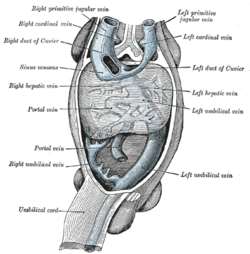| Sinus venosus | |
|---|---|
 Interior of dorsal half of heart from a human embryo of about thirty days, frontal view. (Opening of sinus venosus labeled at center top.) | |
 Human embryo with heart and anterior body-wall removed to show the sinus venosus and its tributaries. (Sinus venosus labeled at center left.) | |
| Details | |
| Carnegie stage | 9 |
| System | Cardiovascular system |
| Identifiers | |
| Latin | sinus venosus cordis |
| TA98 | A12.0.00.016 |
| TA2 | 3911 |
| TE | venosus_by_E5.11.1.3.2.0.4, E5.11.1.5.1.0.1 E5.11.1.3.2.0.4, E5.11.1.5.1.0.1 |
| FMA | 70303 |
| Anatomical terminology | |
The sinus venosus is a large quadrangular cavity which precedes the atrium on the venous side of the chordate heart.[1][verification needed]
In mammals, the sinus venosus exists distinctly only in the embryonic heart where it is found between the two venae cavae; in the adult, the sinus venosus becomes incorporated into the wall of the right atrium to form a smooth part called the sinus venarum which is separated from the rest of the atrium by a ridge called the crista terminalis. In most mammals, the sinus venosus also forms the sinoatrial node and the coronary sinus.[1][verification needed]